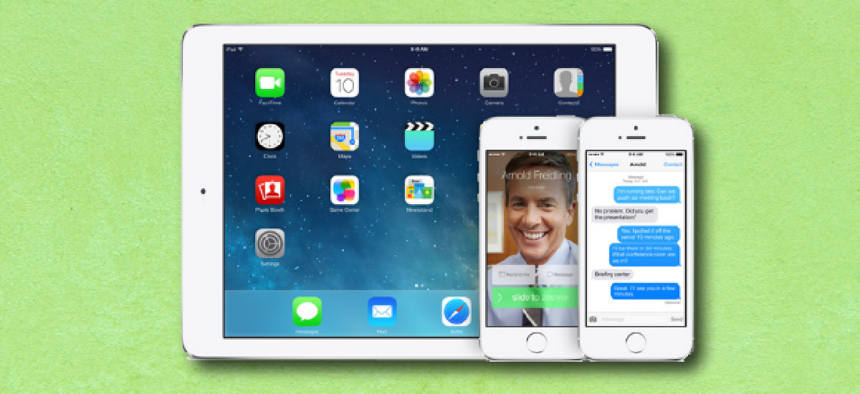BYOD seeds Apple's public-sector growth


Connecting state and local government leaders
The iPhone's and iPad's usability, security and closed ecosystem have made Apple devices an increasingly popular choice for public-sector IT managers.
A recent Wall Street Journal article confirms what government tech purveyors already know: Apple has quickly built a public-sector following.
The newspaper, citing Forrester Research data, noted that Apple captured around 8 percent of the global business and government spend on computers and tablets during 2012. That compares with Apple’s 1 percent dent in enterprise and public-sector spending activity in 2009. Forrester projects Apple’s slice will grow to 11 percent by 2015. The Journal also pointed out that Forrester’s numbers didn’t count iPhone sales.
Peter Oppenheimer, Apple’s senior vice president and chief financial officer, speaking during the company’s January 27 earnings call, said the iPhone and iPad products set all-time company sales records for the quarter ended Dec. 28. The government market contributed to those sales.
Oppenheimer, citing IDC research, said iPhone has a 59 percent share of the U.S. commercial smartphone market when the government, business and education sectors are combined. The iPad line, meanwhile, is capturing school sales. Oppenheimer said U.S. education institutions have purchased more than 7 million iPads. The company has sold more than 750,000 of the tablet devices to K-12 schools in the state of Texas alone, he said, noting that more than 7,000 have been deployed to K-12 students in the Midway Independent School District.
Tim Hoechst, chief technology officer at Agilex, a Chantilly, Va.-based federal solutions provider and a member of the Apple Consultants Network, said he lacks the hard data to corroborate Forrester’s observations, but said the research group’s numbers make sense. Federal agencies have become more willing to adopt Mac OS and the iPad, Apple’s iOS-based tablet that debuted in April 2010, he said.
“There seems there is an increase in acceptance,” Hoechst said.
Intelligent Decisions, a federal IT solutions provider based in Ashburn, Va., has noticed this trend as well. The company, which has long sold Mac gear, now runs a mobility practice and operates a mobile application development subsidiary called daVinci.
“We definitely see the growth,” said Greg Eoyang, president and chief executive officer of daVinci.
Factors driving Apple’s government expansion include the rise of mobility, the bring-your-own-device approach and the perception that Apple products have adequate security.
Broader acceptance
Hoechst said he views Apple’s growing government presence as part of a more general trend in technology uptake.
“It has to do with an increasing willingness in government to broaden their acceptance of the technologies that their users demand, rather than the ones that are bulk purchased from on high,” he said.
Government isn’t simply focusing on lowest cost, Hoechst continued, “but rather is starting to look at total value and impact on the user. So, while most computer purchases are still a commodity buy, exceptions today are more common."
Hoechst said he includes other mobility solutions, open source technologies and cloud-based infrastructure on the list of items federal IT managers are more open to adopting. He said CIOs who have said “no” to innovation in the past because of security, privacy or system availability concerns are now looking for a way to say “yes.”
“Increasingly, they are finding themselves potentially marginalized when they continue to say no,” Hoechst said, noting that organizations can find a way around the official purchasing channels.
Indeed, the rigidity of traditional procurement has started to ease somewhat.
“It used to be that you had to have your technical reference architecture,” Eoyang said, noting that technologies left off that list were unlikely to appear in agencies.
“People have loosened up a little bit,” he added.
Laura Moon, vice president of alliances and strategic partnerships at Intelligent Decisions, cited the ease-of-use factor as also propelling Apple’s government growth and the growth of mobility in government as a whole.
Management concerns
The usability hook brings in consumers, but IT personnel focus on other priorities. Manageability and security rank among their top concerns. A MeriTalk report, published in October 2013, noted that 74 percent of federal IT security professionals said they are not “prepared to support secure access for mobile devices.”
That said, Hoechst suggested that IT managers now have a certain comfort level with iOS and Mac OS from a security point of view. The perception of security has been bolstered by iPhone and iPad devices’ resilience to malware, he said. Overall, the proprietary nature of Apple’s operating systems, Mac OS included, provides IT managers with the advantage of a closed ecosystem and a smaller target space.
"Historically, Apple’s smaller user base has made their devices less of a target for malware,” Hoechst added. "By the same token, Apple has been able to maintain more control over the devices by developing both hardware and software, which limits the number of variances that can become vulnerabilities. And due to widespread demand for the iPads specifically, IT has been forced to learn how to manage and secure Apple devices and have found that it is not that difficult.”
Hoechst said the security perception has built up over time and lingers in the background thinking of IT managers. Meanwhile, the image of Apple as a pricy brand has changed among IT departments.
“They have shifted from, ‘They are more expensive’ to ‘They are more manageable,’” Hoechst said. “That shift has made a big difference.”
Eoyang said Apple’s mobile ecosystem security strengths and weaknesses are better understood compared to Android and Windows Phone 8. He said he believes the security issues are not as comprehensively vetted on the latter platforms. In general, Eoyang contended that mobile security has matured to the point where there’s not a huge difference between the security issues surrounding a tablet and those impacting a conventional laptop.
NEXT STORY: NIST draft standard details approximate matching




